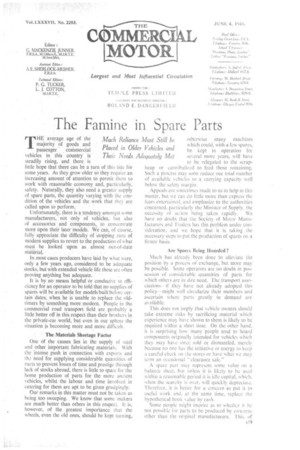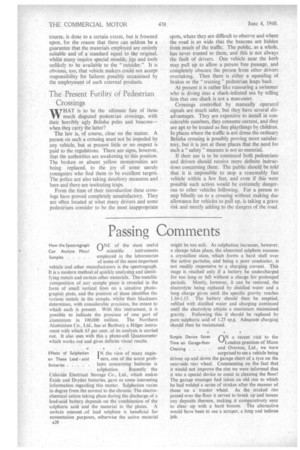The Famine in Spare Parts
Page 21

Page 22

If you've noticed an error in this article please click here to report it so we can fix it.
THE average age of the majority of goods . and passenger. . commercial vehicles in this country . is steadily rising, and there. is little hope that there can be a turn of this tide for some years. As they grow older so they require an increasing amount of attention to permit them to work with reasonable. economy and, particularly, safety. Naturally, they also need a greater supply of spare parts, the quantity varying with the condition of the vehicles and the .work that they are called upon to Perform.
Unfortunately, there is a tendency amongst some manufacturers, • not only of vehicles, but also of accessories . and components, to concentrate more upon their later Models. We can of courSe, fully appreciate the difficulty of stopping runs of modern supplies to revert to the production of what Must be looked upon as . almost out-of-date Material. • • In most cases producers have laid by what were, only a few years ago, :considered to be adequate stocks; but with extended vehicle life these are often proving anYthing but adequate: It is by no means helpful:circonducive to efficiency for an operator to be told that no supplies of spares will be available for models built before certain dates.; When he is Unable to replace the oldtimers hy.Something more modern. 'People in the commercial road transport field are probably 'a little better off in this respect than their brothers in the private-ear world, but even in our sphere the situation is becoming mote and more difficult.
"The Materials Shortage Factor One of the Causes lid in the Supply of steel and Other important fabricating materials. With the intense push in connection with exports and the peed for supplying. considerable quantities of narts to prevent losses of time and prestige through lack of stocks abroad, there is little to spare for the home production of parts for the more ancient vehicles,. whilst the labour and time involved in catering for them are apt to be given grudgingly.
Our remarks in this matter must not be taken as being too sweeping. We know That some makers are mueh better than others in this respect. It is, however, of the greatest importance that the wheels, even the old ones, should be kept turning, otherwise many machines which could, with a few spares, be kept in operation for several more years, will have to be relegated to the scrapheap or cannibalized to feed those remaining. Such a process may soon reduce our total number of available vehicles to a carrying capacity well below the safety margin.
Appeals are sometimes made to us to help in this matter, but we can do little more than express the fears entertained, and emphasize to the authorities concerned, particularly the Minister of Supply, the necessity of action being taken rapidly. We have no doubt that the Society of Motor Manufacturers and Traders has this problem under con.sideration, and we hope that it is taking the necessary steps to put the production of spares on a firmer basis.
Are Spares Being Hoarded ?
Much has already been done to alleviate the position by a process of exchange, but more may be possible. Some operators are no doubt in possession of considerable quantities of parts for . which others are in dire need. The transport associations—if they have not already adopted this policy—might well circularize their members and ascertain where parts greatly in demand are available.
This does not imply that vehicle owners should take extreme risks by sacrificing material which experience may have shown to them is likely to be required within a short time. On the other hand. it is surprising how many people tend to hoard components originally intended for vehicles which they may have since sold or dismantled, merely because no one has the initiative or energy to keep a careful check on the stores or have what we may term an occasional clearance sale."
A spare part may represent some value on a balance sheet, hut unless it is likely to be used within a reasonable period it is idhe capital. which. when the scarcity is over, will quickly depreciate.. Therefore, it is better for a concern to put it to useful work and, at the same time, replace the hypothetical book value by cash.
Some people might inquire as to whether it be not possible for parts to be produced by concerns other than the original manufacturers. This: of course, is done to a certain extent, but is frowned upon, for the reason that there can seldom be a guarantee that the materials employed are entirely suitable and of a standard equal to the original, whilst many require special moulds, jigs and tools unlikely to be available to the "outsider." It is obvious, too, that vehicle makers could not accept responsibility for failures possibly occasioned by the employment of such external products.
The Present Futility of Pedestrian Crossings WHAT is to be the ultimate fate of those much disputed pedestrian crossings, with their horribly ugly Belisha poles and beacons— when they carry the latter? The law is, of course, clear on the matter. A person on such a crossing must not be impeded by any vehicle, but at present little or no respect is paid to the regulations. There are signs, however, that the authorities are awakening to this position. The broken or absent yellow monstrosities are being replaced, to the joy of some unruly youngsters who find them to be excellent targets. The police are also taking desultory measures and here and there are instituting traps. From the time of their introduction these crossings have proved completely unsatisfactory. They are often located at what many drivers and some pedestrians consider to be the most inappropriate spots, where they are difficult to observe and where the road is so wide that the beacons are hidden from much of the traffic. The public, as a whole, has never trusted to them, and this is not always the fault of drivers. One vehicle near the kerb may pull up to allow a person free passage, and completely obscure the person from other drivers overtaking. Then there is either a squealing of brakes or the " trusting " pedestrian leaps back. At present it is rather like reassuring a swimmer• who is diving into a shark-infested sea by telling him that one shark is not a man-eater. Crossings controlled by manually operated signals are much safer, but they have several disadvantages. They are expensive to install in considerable numbers, they consume current, and they are apt to be treated as fine playthings by children. In places where the traffic is not dense the ordinary Belisha crossing is possibly proving more satisfactory, but it is just at these places that the need for such a "safety " measure is not so essential. If their use is to be continued both pedestrians and drivers should receive more definite instructions concerning them. The public should be told that it is impossible to stop a reasonably fast vehicle within a few feet, and even if this were possible such action would be extremely dangerous to other vehicles following. For a person to step blindly on to a crossing without making due allowance for vehicles to pull up, is taking a grave risk and merely adding to the dangers of the road.
















































































